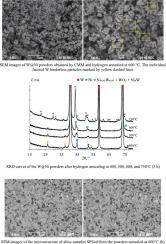低温火花等离子烧结精细耐火复合粉末的芯壳:以粉末为例W@Ni
IF 4.6
2区 材料科学
Q2 MATERIALS SCIENCE, MULTIDISCIPLINARY
International Journal of Refractory Metals & Hard Materials
Pub Date : 2025-09-06
DOI:10.1016/j.ijrmhm.2025.107428
引用次数: 0
摘要
研究了W + 10% wt. Ni粉末快速低温放电等离子烧结(SPS)的机理。粉末组成有两种方法:(i)将W和Ni粉末按规定比例混合(以下简称W + Ni);(ii)通过在亚微米W颗粒表面沉积Ni,形成具有W核- Ni壳结构的颗粒(以下简称W@Ni)。为了降低氧和氧化物的浓度,粉末在氢中退火。固相烧结在不同温度(1000 ~ 1150℃)、压力(40 ~ 80 MPa)、升温速率(50 ~ 500℃/min)和等温保温时间(0 ~ 20 min)下进行。烧结温度对应于W在Ni中强烈溶解的开始。样品的相对密度高,晶粒尺寸小。混合粉末的SPS活化能接近于晶界扩散活化能。SPS过程中W@Ni颗粒压实的关键机理是蠕变。烧结温度的升高导致W在Ni中的溶解度增加,从而导致冷却过程中形成的二次Ni4W颗粒数量增加。晶粒长大对W合金力学性能的影响小于相组成的变化。本文章由计算机程序翻译,如有差异,请以英文原文为准。

Low-temperature Spark Plasma Sintering of fine refractory composite powders core-shell: A case of the powders W@Ni
The mechanisms of fast low-temperature Spark Plasma Sintering (SPS) of W + 10 % wt. Ni powders were investigated. The powder compositions were obtained in two methods: (i) by mixing W and Ni powders in a specified ratio (hereinafter referred to as W + Ni); (ii) by Ni deposition on the surface of submicron W particles allowing the formation of particles with a core W – shell Ni structure (hereinafter referred to as W@Ni). To reduce the concentrations of oxygen and oxides, the powders were annealed in hydrogen. The solid-phase sintering was performed at various temperatures (1000–1150 °C), pressures (40–80 MPa), heating rates (50–500 °C/min), and isothermal holding times (0–20 min). The sintering temperatures corresponded to the onset of intense dissolution of W in Ni. The samples had high relative density and small grain sizes. The activation energy of SPS of the mixed powders was close to the one of the grain boundary diffusion. The key mechanism for the compaction of W@Ni particles in the SPS process is Coble creep. The increasing of the sintering temperature was shown to lead to an increase in the solubility of W in Ni and, consequently, to an increase in the number of secondary Ni4W particles formed during cooling down. The grain growth has a minor effect on the mechanical properties of the W alloy compared to the changes in its phase composition.
求助全文
通过发布文献求助,成功后即可免费获取论文全文。
去求助
来源期刊
CiteScore
7.00
自引率
13.90%
发文量
236
审稿时长
35 days
期刊介绍:
The International Journal of Refractory Metals and Hard Materials (IJRMHM) publishes original research articles concerned with all aspects of refractory metals and hard materials. Refractory metals are defined as metals with melting points higher than 1800 °C. These are tungsten, molybdenum, chromium, tantalum, niobium, hafnium, and rhenium, as well as many compounds and alloys based thereupon. Hard materials that are included in the scope of this journal are defined as materials with hardness values higher than 1000 kg/mm2, primarily intended for applications as manufacturing tools or wear resistant components in mechanical systems. Thus they encompass carbides, nitrides and borides of metals, and related compounds. A special focus of this journal is put on the family of hardmetals, which is also known as cemented tungsten carbide, and cermets which are based on titanium carbide and carbonitrides with or without a metal binder. Ceramics and superhard materials including diamond and cubic boron nitride may also be accepted provided the subject material is presented as hard materials as defined above.

 求助内容:
求助内容: 应助结果提醒方式:
应助结果提醒方式:


